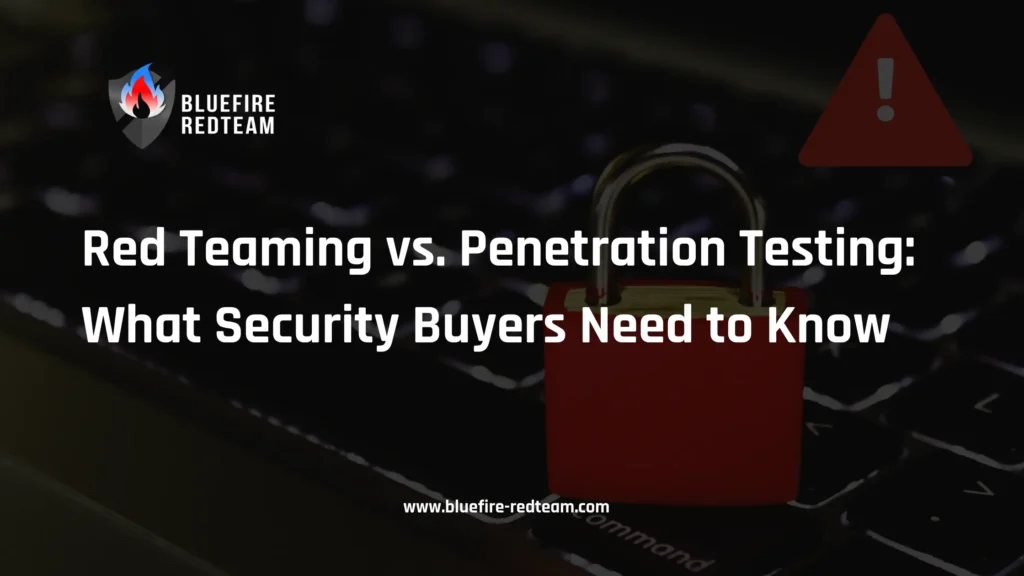Introduction
As a security leader or CISO, you have undoubtedly had to decide whether to spend money on red teaming, penetration testing, or both. Although these terms are frequently used synonymously, they actually refer to two quite different methods of assessing the defences of your company. Making the correct choice could mean the difference between checking a compliance box and identifying important attack routes before an adversary does.
In this guide, we’ll break down the key differences between penetration testing and red teaming, explain when each is most valuable, and show you how to align your security investments with your organization’s risk profile. By the end, you’ll know exactly which assessment your business needs—and how Bluefire Redteam can help you execute it.
What Is Penetration Testing?
Penetration testing (or pen testing) is a simulated attack against a specific application, system, or network to identify vulnerabilities that an attacker could exploit.
- Objective: Find and report technical vulnerabilities.
- Scope: Narrow, usually limited to defined systems or applications.
- Approach: Time-boxed, checklist-driven.
- Outcome: Technical report with vulnerabilities and remediation guidance.
- Best Fit: organisations looking to find software misconfigurations or satisfy compliance requirements.
Think of a penetration test as a targeted health check-up: it focuses on known areas of concern and delivers a clear list of fixes.

What Is Red Teaming?
Red Teaming is a full-spectrum adversarial simulation that goes far beyond finding vulnerabilities. Instead, it tests your entire organization’s ability to detect, respond, and withstand a real-world attack.
- Objective: Emulate realistic adversary tactics and test resilience.
- Scope: Broad—people, processes, and technology are all in play.
- Approach: Stealthy, adaptive, and often multi-phase (initial compromise → lateral movement → objective execution).
- Outcome: Executive-level narrative of how attackers could achieve business-impacting goals.
- Best Fit: Mature organizations that want to validate incident response and prioritize investments.
Red Teaming is more like a fire drill for your entire security program—testing not just the locks on the doors, but how your team responds when an intruder slips inside.

Comparison: Red Teaming vs. Penetration Testing
| Feature | Penetration Testing | Red Teaming |
|---|---|---|
| Primary Goal | Identify vulnerabilities | Emulate real attackers to test resilience |
| Scope | Narrow, defined systems | Broad—people, processes, and technology |
| Duration | 1–2 weeks | 4–12 weeks |
| Tactics | Known exploits, vulnerability scans | Stealthy, adaptive, multi-phase attack chains |
| Output | Vulnerability report | Executive risk narrative + detection/response gaps |
| Best Fit | Compliance & first-time assessments | Mature organizations with active defense teams |
When to Choose Penetration Testing
Pen testing is ideal if your organization:
- Must adhere to compliance standards (such as PCI DSS, HIPAA, SOC 2, etc.).
- Has never conducted a formal vulnerability test on systems.
- operates on a limited budget or with a low level of security maturity.
- Wants tactical fixes for applications, networks, or cloud environments.
For many organizations, penetration testing is the necessary first step before moving on to advanced assessments like red teaming.
When to Choose Red Teaming
Once fundamental security procedures are established, red teaming becomes useful. Select this strategy if your company:
- Regularly performs penetration tests already.
- Uses a blue team or SOC that requires verification.
- Works in high-risk sectors like critical infrastructure, healthcare, and finance.
- Wants to measure ROI of existing security investments.
- Needs to assess real-world resilience, not just vulnerabilities.
For executive buyers, Red Teaming delivers strategic insight: How would an attacker actually impact our business, and how quickly would we detect them?
The CISO’s Buying Checklist
Before engaging with a security vendor, ensure you:
- Define your primary objective: Compliance vs. resilience.
- Match scope to maturity: Narrow vulnerability assessment vs. holistic adversarial simulation.
- Ask vendors the hard questions: Do they only report vulnerabilities, or do they provide adversarial insights tied to business risk?
- Demand post-engagement support: True value comes when findings are translated into remediation, detection, and response improvements.
Red Teaming Case Study
For years, an enterprise client relied on yearly penetration tests. They easily passed audits, but they were unaware of the potential targets of attackers. We used a customised social engineering campaign to successfully get around multi-factor authentication during a red team engagement by Bluefire Redteam. The outcome? The company closed a gap that pen testing never found by reallocating funds to strengthen identity controls and employee awareness training.
Watch a short video on our recent physical and digital red teaming assessment.
ROI and Business Impact
- Penetration Testing ROI: Immediate vulnerability fixes, compliance readiness.
- Red Teaming ROI: Strategic visibility, faster detection and response, reduced likelihood of business disruption.
Executives don’t just want a list of vulnerabilities—they want assurance that security investments reduce risk in measurable ways. Red Teaming bridges that gap.
Frequently Asked Questions - Red Teaming vs. Penetration Testing
- Can Red Teaming replace penetration testing?No. Red Teaming builds on penetration testing. Both have unique value depending on your maturity and goals.
- How often should we run a red team engagement?Most mature organizations run them annually, or after major security program changes.
- Do we need both services?Yes, over time. Pen testing ensures tactical fixes; Red Teaming validates your overall resilience.
Conclusion
There is a common misconception that penetration testing and Red Teaming are competing services. One must get the other’s service done on their system, the other doing the development. Penetration testing (pen testing) is done for ensuring vulnerabilities are patched. With Red Teaming, you test if your defense is working against a real adversary.
If you are a security leader wanting to transition from compliance-driven assessments to a resilience-first security posture, Bluefire Redteam is at your disposal. Our experts design engagements providing tailor-made solutions in line with your business risk considerations and insights that will be presented before the executives.
Schedule a consultation with Bluefire Redteam today to discover whether penetration testing, red teaming, or a combined approach is right for your organization.


